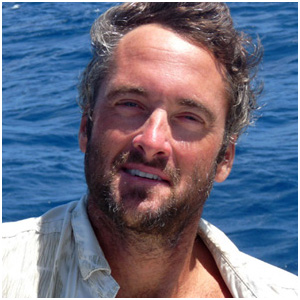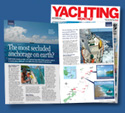
|
|
 |
Day 1,571 - Mudeford, England (50° 43.2N 01° 44.5W)
18:56hrs - September 17th 2011
Where It All Began |

There are no palm trees here, the sand is littered with toe-stubbing stones, and the water is often cold enough to make even the most seasoned member of the Polar Bear Club pause and think twice before going for a swim. In fact sometimes, OK, quite frequently actually, summer never actually seems
to arrive at this corner of the world (enter the lat' and long' above into
Google Earth to see exactly where we are). But it's here, in a place that
sounds more like a country farm than a unique beach community,
that our adventure together began.
Twenty years ago, it was here, in Mudeford, that Catherine and I lit our first beach fire together - cooking sausages over burning driftwood. It was here, during one of our first dates, where we took our first passage - in a ten foot
row boat across the harbour, and it was here where we fell in love, not only
with each other, but perhaps with a lifestyle that, two decades later, we are living together on Dream Time.
Mudeford, which is in England by-the-way, on the south coast near Bournemouth, is nothing more than a sandy spit, a thin stretch of land that extends east from Hengistbury Head, separating Christchurch Harbour from the open waters of Christchurch Bay and the English Channel just the other side of the Isle of Wight. But what makes Mudeford unique is that it is home,
a few months of the year at least, and weather providing of course, to a small and lucky community of hardy beach lovers. People who spend long weekends, holidays, or even all summer, living quite happily without many of life's conveniences, and who are willing to sleep in confined quarters, in this case huts no larger than a garden shed, enjoying the escape, much like cruisers, from the hustle and distractions of modern day living.
My Father bought our beach hut, number 161, forty-one years ago, coincidently in the same year I was born, during my very first summer, so you could say that I was destined to spend my life by the sea, and from that summer on, that's exactly what we did. Whenever it wasn't raining, and frequently even when it was, our family happily spent the holidays at Mudeford Spit, living on, in and around the sea. And a few years later, when I was old enough to swim, or at least float, my Father taught me how to sail - in a tiny wooden boat not much bigger than our inflatable dingy.
If you haven't already guessed, Catherine and I have taken a short trip over
to England to visit family (yes, we flew), and we've managed to steal away
a few days to visit what, even after exploring some of the more glamorous corners of the world, remains one of my favorite places. The weather has been unbelievable, warm enough in sunbath in fact, which is remarkable - an 'Indian Summer' according to our beach hut neighbor, who, again, like cruisers, seem to dedicate entirely too much time discussing the weather.
A lot has changed here since 1993 - when Catherine and I last slept in the hut; hissing gas lanterns have given way to high-tech LED lights powered by solar panels that also run, in the more modern huts, fridges, water pumps, hot water tanks, and even, to the shock of many of the original settlers, televisions.
Cracker Jack (our beach hut, aptly named by my Father, Jack) has recently been rebuilt, and is now tricked-out with a 100-watt solar panel and a fancy new 12-volt system similar to Dream Time's, and even, after forty years of enduring a Pardey-like 'bucket & chuck-it' philosophy, a tiny head. So with no mains water supply, a tiny galley, a folding dinner table, and an electrics breaker panel (purchased from a chandlery shop) displaying switches for the 'Main Cabin Light', 'Water Pressure', and 'Engine Room', it feels like we're on the boat, but without having to worry about the anchor dragging.
But with all the mod-cons, the occasional ringing of a nearby cell phone, or even the muffled drone of a distant TV set, the spirit of Mudeford is still very much the same, and the community of 365 huts, that lease tiny patches of
sand from the council, has managed to retain its unique and undeniable charm. And for those of you who like the idea of owning your very own beach hut, good luck trying to get one. No additional huts have been built for well over thirty years, and the average hut, which sold for around $4,000 when I was a lad, now sell, very quickly, for an astonishing $250,000. But as any Mudefordian will tell you, you can't put a price on paradise.
|
|

| |

Hot Off The Press!
Click here to read our
article in the September
issue of Yachting Monthly magazine >
|

|








![]()